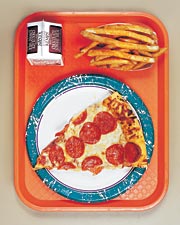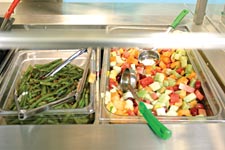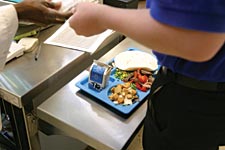 |
It’s lunchtime, and the aroma of sesame noodles and baked chicken drifts through the halls at Perspectives Charter School on Chicago’s Near South Side. In the school’s kitchen, two men in black chef’s clothes stir broccoli, snow peas, baby corn, and cut chicken in 40-quart pans with a little oil, garlic, and ginger. Soon, they’ll bake the preparation for the second lunch shift. Meanwhile, the sixth graders on the first shift are filing into the skylit lunchroom, almost every one of them looking eagerly into the big bowls-full of noodles, the chicken and vegetable mix, and green salad-laid out for them on the lunch line.
“I really like the food,” says Chastity Daniel, a sixth grader clad in the school uniform of light blue shirt and black pants. “It’s hard to find something that’s healthy and good, but they do it.”
The lunch at Perspectives ranks as the gold standard for schools these days. Meals are made from scratch on the premises, with an emphasis on fresh ingredients. Fried foods are out, as is chocolate milk. Chips were out, too, until a student pointed out to Lisa Gershenson, the head chef, that baked chips were healthful; now the kitchen team occasionally bakes pita chips. Even notoriously kid-hostile items like asparagus and green peppers show up on the Perspectives menu. “It’s like a badge of honor at this school to say, ‘I tried the asparagus-and I liked it,'” Gershenson says. “We think of the lunchroom as an extension of the classroom.”
Clearly, school lunch has come a long way from the days of Mystery Meat and Tater Rots. Few schools feed their students as well as Perspectives does, but everywhere you look, school districts and the food companies that serve their lunches have made improvements in the meals they offer-and more improvement is likely.
Tiny kids are feasting at pint-size, bright-colored salad bars. High schoolers are seeing the size of an order of french fries cut in half. Hardly anything is fried anymore. “Your school lunch is much better now,” says Linda Van Horn, the editor of the Journal of the American Dietetic Association and a Northwestern University professor of preventive medicine. “But there’s a lot more that needs to be done.” Van Horn envisions the school lunchroom becoming what she calls the lunch lab: “You go to the math lab and the chem lab,” she says. “In the lunch lab, you’d do taste tests, learn about what constitutes a meal, find out why this apple is good for you and how many calories are in it.”
That’s a bit far-fetched, but it may be just what today’s kids need. Nationwide, childhood obesity has turned into a severe health problem, and the rate in Chicago doubles the national average. (A 2003 study by the Chicago Public Schools and the Consortium to Lower Obesity in Chicago Children determined that 23 percent of Chicago’s kindergartners and pre-K students were overweight, compared with 10.4 percent nationally.) “In our country, generation after generation has been healthier than the last and lived longer than the last,” says Rochelle Davis, the executive director of the Healthy Schools Campaign, a national effort based in Chicago. “What’s startling about the obesity epidemic is that it has the potential of changing that trend.”
Prompted by the weight problems, a new federal law requires that every school district in the country that participates in the federal school lunch program-and that’s the great majority of districts in this area-must have a “local wellness policy” in place by next fall. Illinois tightens the federal rule significantly, with a specific goal from the state education department that these standards be “health-promoting,” not just mirror the status quo. “We are all taking this very seriously,” says Sue Susanke, the director of logistics for the Chicago Public Schools, who runs food service and other programs. “We want to introduce more fresh fruits and vegetables, use more low-fat meats, change some eating patterns that have developed.”
Beyond the battle of the bulge, the healthy lunch campaign follows studies showing that improved nutrition makes for better school performance and enhanced health and longevity. Even in an elite place like Lake Forest, which gets no federal funds for lunch and thus is not required to create a wellness policy, parents have lobbied to enhance the lunch. Food service director Barb Stout says that until a few years ago, students buying the hot lunch got cookies or some other sugary dessert a few times a week. Now, at parents’ request, they get it just twice a year, once in November and once in June. “Parents told us, ‘You know what? They don’t need all those sweets,'” Stout recalls. “And they were right.” Fruit took the place of dessert, in most cases.
“Parents have very high expectations for the meal their children eat in school,” says Mark Friedman, the superintendent of District 70, encompassing the elementary schools in Libertyville. “No matter what they’re feeding their children at home, they want to know that the lunch we give at school is very good and something their kids will want to eat.”
The schools that still serve glop on toast have become the rare exception. Even schools that lack kitchens and thus are limited to heat-and-serve meals-far less tasty than kitchen-cooked lunches-now offer salads, cold sandwiches, and other, more appetizing alternatives. In school lunchrooms in both the city and suburbs,
I saw children queuing up for baked chicken with barbecue sauce, all-fruit smoothies, turkey wraps, salads, and other foods that were both good for them and appetizing. High schoolers in particular get the chance to make their own choices; in the Oak Park and River Forest High School cafeteria, for every student I saw making a meal of a chocolate doughnut or a burrito and fries, there were three more eating fruit and a wrap, or a fruit salad and water.
 |
The notion of serving lunch at school originated half a century ago in a very different America. So many boys had entered the U.S. military malnourished in World War II that “it was seen as a matter of national security to feed children better,” says Davis of the Healthy Schools Campaign.
The meat and dairy industries and other food makers signed on with what would become a mammoth program of donating food in bulk to the nation’s schools. Ever since, donated “commodity foods,” such as meat, cheese, and canned fruit, have provided a sizable chunk of what school kids eat. The Chicago Public Schools district alone will get $11 million worth of commodity food this year, Susanke says: turkey, canned and frozen fruits and vegetables, some fresh fruit, hamburgers, beef roast, cheese, fruit juice.
Worthy as the donations may be, Northwestern’s Van Horn argues that the program serves primarily a defunct purpose: fattening up children. “Back in the late forties and fifties, when the school lunch program started, there was a problem with hunger in this country,” she says. Donations of commodity food “gave us the opportunity to provide calorically dense foods in what might be the only meal some of those kids got on any given day. The American Academy of Pediatrics would have screamed like crazy if anyone had tried to modify the fat; for a growing child, the fat was considered necessary to meet their energy needs.”
Over the years, the school lunch became a national institution, but certainly no treasure. Yucky food and surly servers became the accepted image. Then America’s eating habits changed. Today’s parents take their kids out to eat more often, at everything from fine restaurants to fast-food joints. That has made this generation of children both more demanding of choice at meals and fatter, Van Horn says. Modern parents also rely more heavily on the school lunch, because their lives are too hectic to spend time planning dinner.
“Thirty years ago, the school lunch was not the focal meal of the day,” Van Horn says. “Your dinner was probably something your mother thought a lot about, and she made sure she prepared the healthy things you needed. But we all know what’s happening-parents are busy, and kids are eating dinner at McDonald’s.”
Many school food officials have borrowed from the ambiance (though not, for the most part, the content) of those familiar and popular fast-food spots. With overhead menu boards touting Mexican food, pasta, smoothies, and other offerings, the cafeteria at Oak Park and River Forest High School has the look of a shopping mall food court. “It’s what they know,” says Mike Piekarski, the school’s director of food service since 1991. “They’re used to variety.” Students have a choice of 15 different entrées-on a recent day they included rib patties, corn dogs, bagel pizzas, regular pizzas, veggie burgers, chicken fingers, cold sandwiches, burritos, salads, and wraps, among others. On the day I visited, pizza was by far the most popular dish, followed by chicken fingers, but I also spotted plenty of students eating fruit salad. The tables were dotted with bottles of PowerAde, as well as some containers of water or milk. (Soda is not allowed at lunch.)
Even at the elementary school level, lunch programs today bet on variety. Although skeptics might think that giving first and second graders the chance to choose their lunch invites chaos and delay, school officials say kids that age-accustomed to making choices in restaurants-pick their food swiftly. “Kids demand choices today, and they know how to choose, so we have four entrées every day-two hot entrées, a salad, and a sandwich,” says Bob Bloomer, the Chicago regional vice president for Chartwells-Thompson, the national company that provides lunches for all of Chicago’s 435 public schools with kitchens (the 199 schools without kitchens serve prepackaged heat-and-serve food from Preferred Meals, a Berkeley, Illinois, company).
Northwestern’s Van Horn gives Chart-wells-Thompson high grades for healthy offerings. “They are completely devoted to the lifetime-learning emphasis on school lunch,” she says. One example is the emphasis on fruits and vegetables, proven ingredients in long-term health. Margie Saidel, Chartwells’ director of nutrition, says the company is working to increase children’s appetite for these healthy staples. She says it’s OK if kids don’t eat every bite of the fruit or vegetable that’s put in front of them.
“A few bites is enough to get small children familiar with the vegetable. If they throw the rest away, at least they tried it and they’ll try it again some other time.” She also likes to see lunchrooms broaden the palates of their little customers by introducing fruits that might be new to kids, such as kiwi. “It’s fuzzy and it’s not obvious how to eat it right,” Saidel says. “But after you’ve seen it cut in half or served with a spoon so they can scoop it out, after a while it tends to become a child’s favorite fruit. He might take it on his tray and throw it away a few times before he tries it, but he’s going to get around to eating it.”
In the lunchroom, children not only eat but learn how to eat, says Libertyville’s Friedman. “You can change kids’ eating habits to a healthier style by making things like turkey dogs or veggie burgers more palatable to them. If they want dip on their carrot sticks, we’ll do that. Hey, they’re eating carrots.”
In District 118 in Palos Park and Palos Heights, board member Susan Hennessy points out that Aramark, her district’s food service provider, has a pizza it dubs “smart pizza,” with reduced-fat cheese and whole grain crusts. “That’s a good choice for a child to make,” she says. At Oak Park and River Forest, Piekarski serves grilled chicken alongside its breaded and hot-and-spicy (and less healthful) counterparts, reasoning that by the time kids reach high school, they know what they should eat. “At this point, it’s up to them,” she says.
But Piekarski makes some choices for the students. This year, she eliminated the eight-ounce serving of french fries and now serves only four ounces. “You don’t need that big a portion,” she says. Similarly, many school districts have already been slimming down what is known as “competitive food.” Several now require that vending machines be stocked with water or sports drinks-either alongside or instead of soda.
For the youngest students, the caution covers even birthday parties, traditionally feasts of cake and candy. “In a school of 600 children, it’s somebody’s birthday almost every day,” says Libertyville’s Mark Friedman. He and others hope parents will cooperate when schools limit birthday celebrations to, say, one day a month or downplay the candy on Valentine’s Day in favor of craft projects or games.
The new federal policy requires each school district to set nutritional standards for all food that is available on campus, whether in vending machines or at classroom parties or after-school sports events. The U.S. Department of Agriculture standard stipulates that on a weekly average, a school lunch should provide 654 to 846 calories daily, depending on grade level, with no more than 30 percent of the calories from fat and no more than ten grams of fat. (The weekly average allows for some days to be higher-fat, higher-calorie meals, as long as it all evens out during the week.) Saidel says parents sometimes worry that those caloric counts are too high “because to a small woman who is probably eating a total of only 1,500 to 1,800 calories a day, 800 in one meal seems like a lot. But it’s not too much food for a growing child, especially a high-school-aged athlete.”
 |
And what’s the cost of these healthier lunches? In much of Chicago, they are free to the students. The Chicago Public Schools serves about 330,000 lunches a day, 89.1 percent of those to children who qualify for a free lunch and another 6.1 percent to those who get a reduced price (the federal government reimburses the schools $2.34 and $1.94, respectively). At Faraday Elementary School, a public school on Chicago’s West Side with about 380 students, just two pay the full price of lunch. Ten pay at a reduced rate, and the rest-perhaps 368 children-qualify for a free lunch. (Because some affluent suburban districts have never had a need for federal lunch funding, their elementary schools have never built kitchens and thus never offered hot lunches. Some of Highland Park’s schools have no cafeterias, for example.)
Chicago elementary- and middle-school students at full price pay $1.60; in high school, it’s $1.85. Most school districts have to keep their costs at or near the federal reimbursement level, but at schools with special programs, those dollars don’t begin to cover the cost of the lunch. At Perspectives, for example, Gershenson puts the kitchen’s per-meal cost at about $3.20. The solution: a Perspectives fundraising office that works to fill the gap. Grants from Natural Ovens Bakery, a health-oriented bread company in Manitowoc, Wisconsin, and donations from Chicago philanthropists enable Gershenson and crew to emphasize nutritious and tasty ingredients. That model is rare, though.
The good stuff is expensive, as Kathy Taylor, food service manager for District 95 schools in Lake Zurich, discovered. At a health fair, she found that high schoolers “thought the 100-percent fruit smoothies were awesome. It’s something that’s really good for them-it’s just natural fruit, no sugar added-and it was a huge hit.” She had misgivings over the price; a smoothie is $2, compared with $1.75 for an entire lunch. She brought them in anyway, and they have been such hot items that she later introduced them at the middle school, with similar results.
Most school districts operate school lunch at a small loss or at breakeven. “They should not be making a profit on lunch, and also not pull money out of the general education fund to subsidize the lunch program,” says Sue Niemczyk, operations vice president for food-service provider Sodexho in Illinois, Wisconsin, and Iowa. “Twenty years ago you saw more programs being subsidized by the general fund, but nobody’s got that kind of money anymore.” The federal government is offering some help: a new program designates about $50 million in fresh produce contributions to school lunches; Illinois will get about $2 million worth of those goods.
Even with the improvements in lunchroom fare, organizations continue to push for more healthful eating. Seven Generations Ahead, an Oak Park environmental group, is partnering with elementary schools in Oak Park, River Forest, and Chicago to bring organic foods into the schools’ fundraising lunches-days when the PTA sells specialty lunches at a small markup to raise money. The group also brings organic farmers to the classrooms to give kids a tangible link to the source of their food. The Logan Square Neighborhood Association, in an 18-month pilot program, brings a fruit or vegetable snack to the first graders at McAuliffe Elementary every day, hoping to help them stay alert and develop good eating habits. And Hennessy, the school board member for Palos Park and Palos Heights, has been urging her district’s food service company and PTA fundraisers to banish all foods, mostly commercial baked goods, with trans fats. Diets high in trans fats, such as partially hydrogenated vegetable oil, which are common ingredients in commercial baked goods and other packaged foods, contribute to heart disease and high cholesterol. But it’s hard to tell kids that the cookies they eat now will stop them short a few decades hence.
Hennessy’s fight is somewhat quixotic-trans fats aren’t on the mainstream’s health radar yet the way other fat is-but her point suits everyone who is working to improve school food. “When these kids grow up, I don’t want them saying, ‘My school did a lot for my brain, but it sure didn’t do much for my body,'” she says. “In our schools, we’re giving these kids the best education we can possibly give them. Why would we provide anything less for them to eat?”
Photography by Lisa Predko


